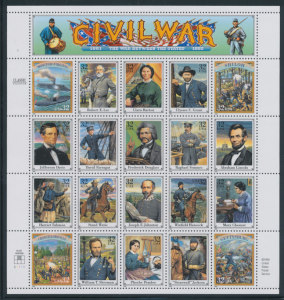 How history is remembered is one of the best ways of determining how a people wishes to understand itself. Currently we are in the midst of the 150th anniversary of the Civil War and this conflict, and the way that it is taught and learned and understood tells us much about ourselves in the early 21st Century. The sheet illustrated above is a USPS 1994 sheet commemorating the Civil War. It is evenly divided between Northerners and Southerners, slaveholders and those who opposed the ownership of human beings. Clearly, 150 years after this great war, which killed nearly as many Americans as all of our other war combined, the consensus that has emerged is that this war was some great cosmic tragedy, two honorable sides on a collision course with no one really at fault. But the Civil War was not inevitable and to believe so is not only a misreading of our history but a misreading of human temperament. America was divided by slavery even before the great Constitutional compromises of 1787-1789 which made ratification of our Constitution possible. As national and international revulsion over slavery increased both sides grew more intransigent with the South resisting all compromise toward ending (or even limiting) slavery and the North ignoring the grave economic loss that uncompensated e
How history is remembered is one of the best ways of determining how a people wishes to understand itself. Currently we are in the midst of the 150th anniversary of the Civil War and this conflict, and the way that it is taught and learned and understood tells us much about ourselves in the early 21st Century. The sheet illustrated above is a USPS 1994 sheet commemorating the Civil War. It is evenly divided between Northerners and Southerners, slaveholders and those who opposed the ownership of human beings. Clearly, 150 years after this great war, which killed nearly as many Americans as all of our other war combined, the consensus that has emerged is that this war was some great cosmic tragedy, two honorable sides on a collision course with no one really at fault. But the Civil War was not inevitable and to believe so is not only a misreading of our history but a misreading of human temperament. America was divided by slavery even before the great Constitutional compromises of 1787-1789 which made ratification of our Constitution possible. As national and international revulsion over slavery increased both sides grew more intransigent with the South resisting all compromise toward ending (or even limiting) slavery and the North ignoring the grave economic loss that uncompensated e

mancipation would represent. Solutions, had people wanted them, were possible right up to Ft Sumpter. Perhaps the greatest tragedy of history is that people are more willing to die than change (or at least politicians are more willing for them to die than to change). And our society's unwillingness to hold responsible those whose intransigence caused the war is a result of this. The USPS sheet treats a war that killed and wounded over 4% of the population (imagine a disaster today harming over 12 million of us) with the wistful nostalgia of a 1950's musical.
